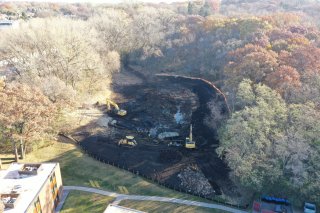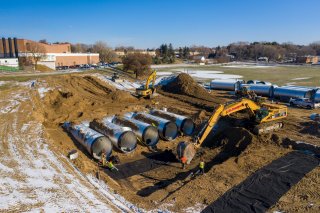Coordinating Off-site Stormwater Management Requirements in Saint Paul, Minnesota
Background
The Capitol Region Watershed District (CRWD) and the adjacent Ramsey-Washington Metro Watershed District (RWMWD) serve the city of Saint Paul, Minnesota, and portions of neighboring suburbs within Ramsey and Washington Counties. The city of Saint Paul has coverage under an individual municipal separate storm sewer system (MS4) permit (the St. Paul MS4 permit), and CRWD and RWMWD have coverage under the Minnesota Small MS4 general permit. Both permits are issued by the Minnesota Pollution Control Agency; each includes a requirement to develop an off-site stormwater management program.
At a Glance
Location: Saint Paul, Minnesota
Mechanisms: off-site mitigation, volume reduction credits, in-lieu fees
Geographic scope: watershed districts
In 2006, CRWD partnered with the RWMWD to create a joint rules adoption process to provide consistent regulations across jurisdictions. This enabled CRWD and RWMWD to work together to establish matching off-site stormwater management requirements in their rules. This process included forming a Technical Advisory Committee, which collects input from regulated public entities. The input informed the development of CRWD and RWMWD’s off-site stormwater management programs, which include what they call alternative compliance sequencing (ACS). For projects that cannot meet the districts’ on-site volume reduction standard, ACS offers three alternatives: off-site mitigation, volume reduction credits, and in-lieu fees.
Program Details
CRWD and RWMWD’s rules include a volume reduction standard, which requires projects to keep a specified volume of stormwater on site through infiltration or other volume reduction methods. The required retention volume is equivalent to 1.1 inches of rainfall over the site’s impervious surfaces. However, the districts recognized that certain site conditions may make infiltration difficult, undesirable, or impossible. Their rules list the following conditions that may limit infiltration and qualify a project for ACS:

- Potential contamination (e.g., potential stormwater hotspots, industrial facilities, contaminated soils or groundwater)
- Physical limitations (e.g., low permeability, bedrock, groundwater, karst areas)
- Land use limitations (e.g., utility locations, adjacent wells)
An owner/developer may also submit an ACS request to the applicable district for site conditions not listed in the rules, but cost is generally not considered an acceptable constraint.
Projects must first attempt to fully meet the volume reduction requirement through on-site infiltration. If site conditions prevent this and the project qualifies for ACS, the project may meet the rest of the volume reduction requirement through any combination of the compliance alternatives offered, but the options must be explored in the following order:
- On-site filtration—filtering a larger retention volume, with specifics depending on the type of filtration used.
- Off-site mitigation or use of credits—construction of a stormwater control measure outside the project site or the use of volume reduction credits to achieve the remaining volume reduction. Note that CRWD and RWMWD’s rules refer to stormwater control measures as best management practices (BMPs).
- In-lieu fees—contribution to the applicable district’s Stormwater Impact Fund (SIF) to cover the cost of implementing the remaining volume reduction elsewhere in the watershed.
Off-site Mitigation
Stormwater control measures constructed at a location outside the project area must provide the same volume reduction benefits as on-site control measures. When possible, the off-site control measure should be within the same drainage area or the same sub-watershed as the project site.
Volume Reduction Credits

One volume reduction credit is equal to one cubic foot of infiltration volume. An owner/developer can generate these credits by constructing voluntary stormwater control measures or control measures that provide retention beyond the volume reduction requirement. A control measure that is oversized to generate credits may not exceed a retention volume of 2.5 inches of rainfall over its impervious drainage area—a limit put in place because of the diminishing water quality benefits for larger stormwater volume capture. Voluntary control measures still require watershed district review and approval. When possible, credits should be generated in the same drainage area or the same sub-watershed as the project site.
Each participating entity’s volume reduction credits are deposited into its credit bank, managed by the applicable district, and tracked via spreadsheet. The districts may approve credit transfers between entities; entities must document the number of credits transferred and conditions of the transfer. For regional stormwater control measure construction, CRWD allows other entities to contribute financially in return for volume reduction credits.
Between 2006 and 2022, over 914,000 credits were generated in CRWD and over 546,000 credits were used by applicants to achieve off-site compliance.
In-Lieu Fee
If a project cannot achieve the full required volume reduction through alternative compliance options, the owner/developer must pay into the applicable district’s SIF. Each district’s board sets its in-lieu fee in units of dollars per acre of site impervious area. The funds cover the cost of implementing a project elsewhere in the watershed that provides the equivalent volume reduction. The districts allocate funds to projects according to their respective SIF Implementation Plans. Local government funds contributed to an SIF must be spent within that local government’s jurisdiction to the extent possible.
Lessons Learned

- Partner with regulated entities to fund regional stormwater projects
- Offering stormwater credits in exchange for financial contributions to regional stormwater projects can allow municipalities/watershed districts to build stormwater control measures in areas that provide the greatest stormwater benefits, while sharing the cost of construction and giving regulated entities flexibility to meet stormwater requirements in future projects.
- Be mindful of setting cost caps for stormwater control measures
- As part of its rules, CRWD established a cost cap in dollars per acre of impervious area for meeting stormwater management requirements on linear projects. When a project’s stormwater costs exceed the cap, CRWD may contribute funds to help the project fully achieve the stormwater management requirements. CRWD may choose this option if site conditions are favorable for a larger stormwater control measure based on soils, available space, drainage area, and receiving water.
- Setting cost caps can create an unofficial benchmark for what is considered a cost-effective stormwater control measure, which can lead to regulated entities being hesitant to pay in-lieu fees or buy credits at a cost higher than that benchmark.
